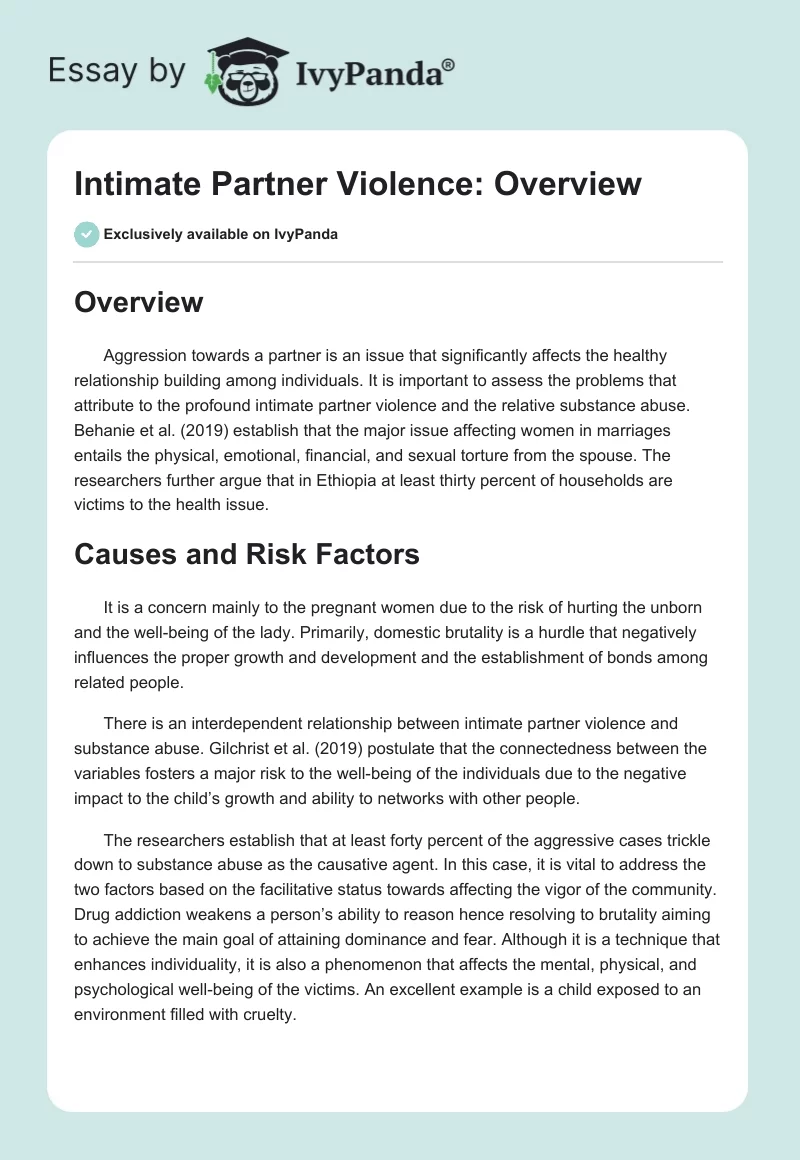Overview
Aggression towards a partner is an issue that significantly affects the healthy relationship building among individuals. It is important to assess the problems that attribute to the profound intimate partner violence and the relative substance abuse. Behanie et al. (2019) establish that the major issue affecting women in marriages entails the physical, emotional, financial, and sexual torture from the spouse. The researchers further argue that in Ethiopia at least thirty percent of households are victims to the health issue.
Causes and Risk Factors
It is a concern mainly to the pregnant women due to the risk of hurting the unborn and the well-being of the lady. Primarily, domestic brutality is a hurdle that negatively influences the proper growth and development and the establishment of bonds among related people.
There is an interdependent relationship between intimate partner violence and substance abuse. Gilchrist et al. (2019) postulate that the connectedness between the variables fosters a major risk to the well-being of the individuals due to the negative impact to the child’s growth and ability to networks with other people.
The researchers establish that at least forty percent of the aggressive cases trickle down to substance abuse as the causative agent. In this case, it is vital to address the two factors based on the facilitative status towards affecting the vigor of the community. Drug addiction weakens a person’s ability to reason hence resolving to brutality aiming to achieve the main goal of attaining dominance and fear. Although it is a technique that enhances individuality, it is also a phenomenon that affects the mental, physical, and psychological well-being of the victims. An excellent example is a child exposed to an environment filled with cruelty.
Prevention
At teenage, the being portrays acts of brutality such as bullying the colleagues. Therefore, it is important to address the interdependence between compulsive behavior and the tendencies to barbarism within a household. The healthy growth of a person is a multidimensional phenomenon that depends on the exposed environment. In this case, it is crucial to establish the main variables that influence the character build-up of an individual. Jones et al. (2018) focused on the interrogation of the dynamic childhood experiences among women in prison. The researchers realized that a significant percentage of the prisoners confessed to adverse childhood encounters due to the prevalence of intimate partner violence.
Majority of the respondents depicted that the course of the crimes emerged from the tendencies of confronting the destructive environment exposed to during teenage years. Therefore, it is a framework that led to the poor character development encompassing the resoluteness to engage in cruel acts as a form of justifying dominance and strength.
Treatment
Consequently, relationship building is a crucial factor among people due to the ability to enhance the social capital and well-being. On the one hand, the dynamic initiatives that render the healthiness of a person involve physical fitness.
On the other hand, the mental and psychological state enshrines the integral exposure to a therapeutic environment. A surrounding filled with violence fosters the development of a behavior oriented to show dominance and focus on brutality as the solution to all problems. It is a condition that risks the health of families especially in the case of substance abuse. Drug addiction impairs reasoning among individuals, hence the vulnerability to show aggression to attain the selfish interest of superiority.
References
Berhanie, E., Gebregziabher, D., Berihu, H., Gerezgiher, A., & Kidane, G. (2019). Intimate partner violence during pregnancy and adverse birth outcomes: a case-control study. Reproductive health, 16(1), 1-9. Web.
Gilchrist, G., Dennis, F., Radcliffe, P., Henderson, J., Howard, L. M., & Gadd, D. (2019). The interplay between substance use and intimate partner violence perpetration: A meta-ethnography. International Journal of Drug Policy, 65, 8-23. Web.
Jones, M. S., Worthen, M. G., Sharp, S. F., & McLeod, D. A. (2018). Life as she knows it: The effects of adverse childhood experiences on intimate partner violence among women prisoners. Child Abuse & Neglect, 85, 68-79. Web.


